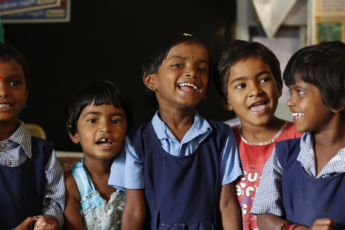The Role of Holistic Infrastructure in Boosting Learning Outcomes
In India, the conversation around improving education often centers around infrastructure. Over the past decade, governments and organizations have invested heavily in building schools, installing toilets, and providing digital tools. While these investments are essential, they haven’t always led to the improvement in learning outcomes that was initially expected. So, what’s missing? It’s not just about creating physical structures; it’s about ensuring that the environment nurtures learning in a holistic way.
At Square Panda India (SPI), we believe that effective school infrastructure goes beyond bricks and mortar. Our approach integrates not only physical spaces but also teacher training, digital content, and community engagement to create vibrant, effective learning environments. A prime example of this is our collaboration with Project TARA, which focuses on transforming Anganwadi centers across India. Together, we’re proving that when infrastructure is combined with pedagogy and community collaboration, real change happens.
Beyond Bricks and Mortar: Why Infrastructure Alone Isn’t Enough
It’s easy to see why infrastructure is seen as a solution to many of education’s challenges. If children have classrooms, desks, and computers, they should naturally be able to learn better, right? Not necessarily.
Infrastructure alone cannot guarantee improved learning outcomes. For example, simply installing smart classrooms or setting up computer labs won’t yield results unless teachers are equipped with the skills and confidence to use these resources effectively. In many schools, computers sit gathering dust because educators are either unsure how to incorporate them into their lessons or feel uncomfortable using the technology.
This is where Square Panda India steps in. We recognize that infrastructure must go hand-in-hand with instruction. Schools and Anganwadi centers must be spaces where children feel engaged and motivated, and teachers must have the tools and training they need to use those spaces effectively. Our efforts focus on three key elements: building better learning environments, improving instruction, and empowering communities.
Collaborating with Project TARA: Transforming Anganwadi Centers
Anganwadis play a critical role in India’s early childhood education system. These centers, part of the government’s Integrated Child Development Services (ICDS) program, are often the first point of contact between young children and formal education. However, many Anganwadi centers are severely under-resourced, with dilapidated infrastructure, lack of basic amenities, and outdated teaching methods.
Through our collaboration with Project TARA, we’ve been working to change that. Project TARA is focused on giving Anganwadi centers a complete facelift, from physical renovations to introducing interactive learning tools. Together, we are helping Anganwadis evolve into vibrant, child-friendly spaces that foster curiosity and learning. Here’s how we’re doing it:
1. Upgrading Infrastructure: A Welcoming Space for Learning
The first step in our approach with Project TARA is transforming the physical space. Many Anganwadi centers are poorly lit, lack proper ventilation, and don’t have the resources that foster a positive learning environment. Working with local authorities, we help renovate these centers, adding elements such as colorful murals, comfortable seating, and proper sanitation facilities.
But we go further than just aesthetics. Functionality is a key part of our upgrades. For example, we ensure that classrooms have proper storage for learning materials, dedicated spaces for reading or play, and areas that encourage active engagement from both children and teachers. Clean, well-maintained toilets are installed to improve hygiene and attendance, especially for young girls.
These upgrades make the space inviting and conducive to learning, but we don’t stop there. We know that a beautiful space without strong teaching practices won’t create the lasting impact we’re aiming for.
2. Teacher Training: Equipping Educators to Make the Most of Their Spaces
Renovating Anganwadis without training the educators who work there would be a wasted effort. Square Panda India invests heavily in teacher training, ensuring that those working in Anganwadi centers are equipped with the skills they need to engage students effectively.
We offer training sessions that cover everything from digital literacy to child-centric teaching methods. Many teachers, especially those in rural or underserved areas, have never had the opportunity to work with interactive technology or modern teaching tools. Our training helps them bridge that gap.
The key to our teacher training program is simplicity and accessibility. We understand that many educators in Anganwadis are not highly trained or tech-savvy, so we design our programs to be user-friendly, offering hands-on practice and continuous support. By empowering educators, we ensure that our infrastructure investments are fully utilized to improve learning outcomes.
3. Digital Tools: Integrating Technology with Pedagogy
Technology can be a powerful tool in education, but only if it is used effectively. In our work with Project TARA, we’ve introduced digital learning tools that are specifically designed for early childhood education. These tools include interactive Smart TVs, tablets, and custom educational content that is aligned with the curriculum.
Our digital tools don’t just entertain; they educate. Through a mix of interactive games, stories, and activities, children can learn foundational skills such as literacy and numeracy. And because our content is adaptive, it meets children at their individual level, allowing for personalized learning experiences that keep students engaged and challenged.
What sets SPI’s approach apart is our focus on integrating technology with pedagogy. Digital tools are most effective when they are used alongside traditional teaching methods, not as a replacement for them. We ensure that educators understand how to blend technology with classroom activities to create a well-rounded learning experience.
4. Community Engagement: Encouraging Parental Involvement
Lastly, we recognize that improving learning outcomes isn’t just the responsibility of schools and teachers—it requires the engagement of the entire community. That’s why Project TARA emphasizes community involvement, particularly from parents.
Through workshops and events, we engage parents and caregivers, educating them on the importance of early childhood education and how they can support their children’s learning at home. We’ve found that when parents are involved, children are more likely to attend school regularly, and learning outcomes improve.
By fostering a collaborative environment where parents, teachers, and the community work together, we’re creating a sustainable model for success. Our goal is not just to improve individual Anganwadi centers, but to create a scalable approach that can be replicated across India.
Measurable Impact: The Results So Far
The partnership between SPI and Project TARA has already led to measurable improvements. In the Anganwadi centers where we’ve implemented this holistic approach, we’ve seen a marked increase in attendance and engagement. Teachers report that children are more enthusiastic about learning, and parents are more involved in their children’s education.
Moreover, our data shows that learning outcomes are improving. Children are reaching literacy and numeracy milestones faster, thanks to the combination of upgraded infrastructure, better-trained teachers, and interactive digital content.
The Final Word
Improving school infrastructure is a vital part of raising learning outcomes, but it’s only one piece of the puzzle. At Square Panda India, we’ve proven that when infrastructure is paired with training, technology, and community involvement, real change can happen.
Our collaboration with Project TARA is a testament to what can be achieved when we take a holistic approach to education. By upgrading Anganwadi centers, empowering teachers, and engaging communities, we’re not only improving education for today’s children but building a better future for generations to come.




Leave a Comment